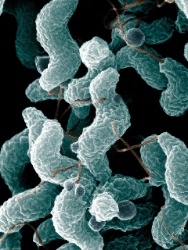Outstanding Medical Research
Media Release
15 Dec 2016
Auckland Medical Research Foundation awards over $2.3 million to medical researchers in second half of 2016, and $2.5m commitment to University of Auckland For All Our Futures Campaign.
The Auckland Medical Research Foundation (AMRF) has recently announced $2,314,926 in funding to medical researchers in the last three of five funding rounds in 2016.
In addition to this, September saw the announcement of a $2.5 million contribution to the University of Auckland Scholars’ Fund for the establishment of the AMRF Senior Research Fellowship, a new 5 year prestigious career fellowship that will be awarded in 2018 in honour of the Medical Schools 50th Anniversary.
Foundation Executive Director Kim McWilliams says, “Congratulations to all recipients. For all our futures it is critical that we to continue to invest in high quality relevant research across the full spectrum of medical science, and continue nurturing future talent.”
The successful grants included 12 research projects ($1,379,180), 1 Postdoctoral Fellowship ($199,473), 4 doctoral scholarships ($454,500), 1 Douglas Goodfellow Repatriation Fellowship extension ($195,924), 2 Kelliher Charitable Trust Emerging Researcher Start-up Awards ($60,000) and 11 travel grants ($25,849) for researchers to present their research. Grants were awarded over a variety of biomedical, clinical, and population health research areas including neuroscience, cancer, infection & immunity, reproduction, development, maternal & newborn health, cardiovascular science, sensory sciences, cellular & molecular biology, and surgery.
See Below for Grant Summaries
The Auckland Medical Research Foundation is a major independent funding agency and charitable trust that provides contestable funding for medical research across the complete spectrum of modern medicine. Over the last 61 years we have distributed over $70 million in funding to a wide range of research activities – currently around $3-4 million annually.
Our Foundation is unique in the charity sector, in that every dollar donated from within the community goes directly and fully (100%) to research. Our administration costs are generously supported by a benefactor.
For further information on the current grants awarded and application forms for future grant rounds see our website at www.medicalresearch.org.nz
ENDS
DOCTORAL SCHOLARSHIPS
RISK ASSESSMENT FOR EMERGENCY LAPAROTOMY ($128,000 - 3 years) 1216005
Dr Ahmed Barazanchi
South Auckland Clinical School, University of Auckland
Emergency laparotomy is a commonly performed surgical procedure with a high mortality and morbidity. Several different operations can be classified as an emergency laparotomy and it is commonly performed on acutely unwell patients as a lifesaving procedure. Predicting outcomes preoperatively is paramount for patient information, planning of perioperative care and deciding on palliative therapies. This study aims to develop a reliable easy to use predictive score based on preoperative patient state. The score will be developed using a retrospective review of Middlemore Hospital patients over the last ten years. The score will be validated and adjusted based on prospective multicentre cohort study run for one year and three months. The risk score will also aim to follow up patients for one year to predict long term impact in the form of ongoing morbidity and quality of life. The risk assessment score will be introduced into a clinical pathway for emergency laparotomy patients. The clinical pathway will provide appropriate level care for high risk patients to reduce overall mortality and morbidity. The proposed study will be the first New Zealand developed emergency laparotomy scoring system. The scoring system will also be the first developed prospectively specifically for emergency laparotomies.
BARBARA BASHAM DOCTORAL SCHOLARSHIP
EXPLOITING BRAIN MECHANISMS TO PROTECT THE PRETERM BRAIN FROM INJURY? ($128,000 - 3 years) 1216004
Mr Hyeon Tae (Kenta) Cho
Dept. of Physiology, University of Auckland
Many preterm infants develop brain injury around the time of birth, with a high risk of life-long disability. Currently, we have no effective way of preventing disability. Our preliminary findings using a well-established animal model of preterm brain injury suggest for the first time that therapeutic manipulation of a critical endogenous neuroprotective anti-inflammatory mechanism can reduce damage to oligodendrocytes, the myelin-producing cells of the CNS. These findings suggest that it is possible to preserve myelination by supporting natural pathways in the brain. However, it remains to be proved whether this therapy will be effective when used at clinically relevant times, with the inevitable delays between injury and initiation of therapy. Thus, to replicate and extend our findings we will robustly test the optimal “window of opportunity” during which this therapy might be instituted to rescue these cells from irreversible damage or cell death.
BRIAN DE LUEN DOCTORAL SCHOLARSHIP
UNDERSTANDING GABA SIGNALLING IN HUMAN PERICYTES IN HEALTHY AND ALZHEIMER’S DISEASE BRAINS ($111,500 - 2 years, 5 months) 1216002
Mr Karan Govindpani
Dept. of Anatomy and Medical Imaging, University of Auckland
Alzheimer’s disease (AD) is a common neurodegenerative disorder, and the leading cause of dementia in elderly patients. It is well-known that the brain vasculature is severely affected in AD, often years to decades before the appearance of clinical symptoms. Pericytes are cells that wrap around small blood vessels in the brain, causing them to expand or contract to change blood flow. The neurotransmitter -aminobutyric acid (GABA) is present at high levels in the healthy brain and has a range of important functions, including the regulation of neuronal excitability. However, the GABA system may become dysfunctional in AD. Since GABA regulates blood flow, we are interested in determining whether GABA may exert this role through contractile pericytes. In this study, we will attempt to detect and locate components of the GABA neurotransmitter system in pericytes and other cells of the brain circulatory system, and to study whether these are altered in AD. In addition, we will test the responses of pericytes to drugs that target the GABA system, with the aim of trying to compensate for changes that we might detect in AD. This research will help to determine whether GABA dysfunction contributes to vascular changes in AD.
CORTICAL EXCITATION-INHIBITION BALANCE IN HEALTH AND DISEASE ($87,000 - 2 years) 1216006
Ms Rachael Sumner
Dept. of Psychology, University of Auckland
Despite the widespread prevalence of depression, currently accepted treatments do not work for approximately one third of patients. One of the key reasons for this is that there remains a fundamental lack of understanding of the biological basis and causes of depression. Continuing advancement in brain imaging techniques provide potentially valuable new methods for measuring biomarkers of central nervous system diseases. Biomarkers can potentially be used for understanding the causes of diseases and for the prediction and evaluation of treatment outcomes. The application of brain imaging techniques for measuring biomarkers of depression will allow new mechanistic insights into the disease process that has not been possible in the past. The main aim of this research is to investigate the use of electroencephalography (EEG) to measure biomarkers of cortical excitation/inhibition and neural plasticity in depression. Reduced neural plasticity has been implicated in a number of brain based disorders, including depression. By targeting visual and auditory evoked neural activity this project will explore how measuring changes in sensory neural plasticity could be used as biomarkers of general brain health in depression.
POSTDOCTORAL FELLOWSHIP
EDITH C COAN RESEARCH FELLOWSHIP
ENDOSCOPIC MAPPING OF GASTRIC SLOW WAVES ($199,473 - 2 years) 1316001
Dr Timothy Angeli
Auckland Bioengineering Institute, University of Auckland
The mechanical contractions that are responsible for breaking down and transporting food through the gastrointestinal (GI) tract are initiated and coordinated by underlying bioelectrical events, termed ‘slow waves.’ In the healthy stomach, slow waves propagate in a routine, highly-organised pattern down the stomach. Abnormal slow wave patterns, termed ‘dysrhythmias,’ have been associated with many digestive disorders, where patients suffer frequent debilitating symptoms including abdominal pain, bloating, nausea, and vomiting. Diagnosis of digestive disorders can be difficult, causing frustration for patients and clinicians, and current approaches for detecting the spatially-complex GI dysrhythmias require surgery. To address this clinical problem, I aim to develop and validate endoscopic (down the throat) gastric electrical mapping as a minimally-invasive technique for diagnosing gastric dysrhythmias, where a custom-designed electrode array will be applied to the inside of the stomach to map slow wave activation patterns. A safe and effective approach for endoscopic delivery will be developed, and the accuracy of the endoscopic electrical recordings will be verified intraoperatively against highly-validated but surgically-invasive recordings. Finally, minimally-invasive gastric mapping will be validated in patients undergoing routine endoscopy. Altogether, this project has the potential to deliver a novel diagnostic approach for debilitating digestive disorders.
DOUGLAS GOODFELLOW REPATRIATION FELLOWSHIP EXTENSION
DEVELOPING ZEBRAFISH ETV6 MODELS OF ACUTE MYELOID LEUKEMIA (AML) FOR CHEMICAL SUPPRESSOR SCREENS ($195,924 – 1 year) 1413001-1
Dr Andrew Wood
Dept. of Molecular Medicine & Pathology, University of Auckland
Acute Myeloid Leukaemia is an aggressive blood cancer and only 60% of children become long-term survivors and those survivors may suffer long-term side effects from treatment. However, if the leukaemia has mutations in the ETV6 gene the outcomes are much worse but the reasons for this are poorly understood. The goal of this project to is make models of ETV6 mutant leukaemias in cells and zebrafish. These models may help define the biological circuity of these leukaemias with the ultimate goal of developing treatments that improve cure rate and quality of life.
PROJECTS
SECONDARY LYMPHOEDEMA ($159,994 - 2 years) 1116012
Dr Jonathan Astin
Dept. of Molecular Medicine & Pathology, University of Auckland
The lymphatic vasculature plays an essential role in fluid homeostasis; it collects excess interstitial fluid and returns it to the bloodstream. Lymphatic vessel dysfunction leads to the painful and debilitating build-up of fluid in the body, termed lymphoedema. Secondary lymphoedema can occur when lymphatic vessels are damaged following the surgical removal of lymph nodes in cancer patients and it is one of the most significant survivorship issues following surgical or radiological treatment of tumours, particularly breast cancer. In
New Zealand, 20% of women who undergo axillary lymph node removal and/or radiotherapy as part of treatment for breast cancer will develop secondary lymphoedema. There is no definitive cure for secondary lymphoedema and symptoms are managed through the wearing of compression garments, lifestyle changes and surgical removal of tissue. Consequently, there is considerable interest in therapies that stimulate lymphatic vessel repair to help prevent lymphoedema. However, we know very little about how lymphatic vessels regenerate following injury. In this project we will develop new models of lymphatic vessel repair and use these to identify the mechanisms and genes involved in lymphatic regeneration. This work will be an important first step in the development of new therapies in the prevention of secondary lymphoedema.
IN VIVO TARGETS OF PLACENTAL EXTRACELLULAR VESICLES ($158,372 - 2 years) 1116022
Prof Larry Chamley, Dr Scott Graham
Dept. of Obstetrics & Gynaecology, University of Auckland
Extracellular vesicles are part of an elaborate system that the foetus uses to control maternal blood pressure as well as, the maternal immune system during pregnancy. Antiphospholipid antibodies are found in some women and cause still-births and recurrent miscarriages. These antibodies also increase the chance that a woman will develop potentially fatal high blood pressure during pregnancy. We have previously shown that antiphospholipid antibodies can change the nature of placental vesicles such that they might cause increased blood pressure and other complications of pregnancy. In this study we will examine the maternal organs, and the cells within those organs, that placental vesicles target. We will also investigate whether treating placentas with antiphospholipid antibodies alters which maternal organs placental vesicles target to. This research will help us to understand how the foetus controls its mother's physiological systems by targeting specific maternal organs to allow normal pregnancies and whether inappropriate targeting of placental vesicles causes diseases of pregnancy.
CLINICAL PROGNOSTIC MODELS IN BREAST CANCER ($72,423 - 1 year) 1116017
Prof Mark Elwood, Prof Ross Lawrenson, Dr Sandar Tin Tin, A/Prof Vernon Harvey, A/Prof Ian Campbell
Epidemiology and Biostatistics, School of Population Health, University of Auckland
This project will develop and assess methods to predict future outcome for women treated for breast cancer. We will use the information in the combined Auckland-Waikato breast cancer registries, provided by over 7000 women with at least 5 years’ follow up from diagnosis; we will develop a New Zealand-specific system to predict breast cancer outcomes, and compare its performance with existing methods, which have all been developed overseas. Such a model will use data collected routinely in current clinical practice, and will be applicable to individual patients, particularly to identify those with likely very good or very poor outcomes.
REGULATION OF DOPAMINE RELEASE BY ENDOCANNABINOIDS ($150,019 - 2 years) 1116016
Dr Peter Freestone, Prof Janusz Lipski
Dept. of Physiology, University of Auckland
The chemical transmitter dopamine underlies many of our basic behaviours, including movement. However, the exact mechanism determining the timing and magnitude of dopamine release in the brain remain unknown, limiting our ability to effectively treat diseases in which dopamine release is affected, such as Parkinson’s disease. I recently discovered that a unique cannabis-like substance produced in the brain (an endocannabinoid) – NADA – can alter the activity of dopamine-producing cells. This particular endocannabinoid is of great interest as it shares a common biosynthesis pathway with dopamine and is therefore of high importance to the pathophysiology of Parkinson’s disease. The current study will use advanced dopamine-detection (electrochemistry) and cell-type specific stimulation (optogenetics) techniques that are ideally suited to studying the complex network underlying dopamine release. These approaches will establish the mechanism by which NADA controls dopamine levels and related movement behaviours. A range of experimental models from living brain slices to freely moving animals will be used to provide a robust translational investigation. The findings will determine whether the NADA-based mechanism is a suitable target for new therapeutic strategies for diseases like Parkinson’s disease – “The saddest of diseases” (James Parkinson 1817).
INVESTIGATION OF TRIM28-KRAB INTERACTIONS ($158,200 - 2 years) 1116014
Dr David Goldstone
School of Biological Sciences, University of Auckland
Mammalian genomes are littered with the remains of previous retroviral infections. During the early stages of development these retroviral sequences are potently and permanently silenced prevent the expression of retroviral genes. This silencing accompanies the wave of differentiation that alters transcription during normal development and acts to shape the genes that are expressed in particular cells. Trim28, a member of the tripartite motif protein family, is the central player is this control and as such has been labelled the master regulator of the human genome. More recently Trim28 has been implicated in cancer and diabetes and obesity. We aim to understand the molecular details that target Trim28 to particular sites within the genome resulting in the silencing of particular genes. This research will lay the foundation to manipulating this system to alter transcription and treat diverse medical diseases.
DEVELOPMENT OF A THYMIDYLATE SYNTHASE BIOMARKER ($138,702 - 2 years) 1116023
A/Prof Nuala Helsby
Dept. of Molecular Medicine & Pathology, University of Auckland
Some cancer patients who are treated with 5-FU, and other related drugs, have an increased chance of treatment failure due to high expression of the drug target (thymidylate synthase). An inherited risk for poor treatment outcome has been reported in a number of
studies. It is possible to look at a patients DNA to see if they have this thymidylate synthase gene variant. But currently when these individuals are identified there is no clear way to decide how to safely and appropriately increase the drug dose. Our project will assess a method of monitoring effective 5-FU concentrations at the drug target in the cell. We want to adapt and improve the method using a technique called targeted peptide analysis. If this test is sensitive, accurate and reproducible enough we may then be able to use this approach to help oncologists to improve the safe and effective use of this drug especially in those people who may have inherited a resistance to this type of treatment.
AUGMENT REALITY AIDED LIVER ABLATION ($110,139 - 2 years) 1116020
Dr Harvey Ho, Dr Peter Swan, Dr Adam Bartlett, A/Prof Andrew Holden
Auckland Bioengineering Institute, University of Auckland
Minimally invasive procedures provide a real alternative to surgical resection for small tumours. Success of the technique depends largely on the accuracy of ablation probe placement for killing tumour cells in-situ, while also limiting damage to healthy tissue. However, 2D ultrasound image based guidance of a probe, as used in current clinical practice, does not provide precise 3D information of the probe tip, therefore the errors need be corrected to have an optimal operational outcome. We propose to develop an Augmented Reality aided navigation system which is delivered through a Head Mounted Display (HMD). We aim to accomplish four tasks over a two-year timeframe: (1) To develop a vision-driven abdominal model incorporating respiration effects; (2) To integrate data from vision and motion sensors for improved accuracy of probe placement; (3) To implement an Augmented Reality environment delivered through a HMD; and (4) To validate the algorithms using a 4D ultrasonic scanner and an abdominal phantom. Successful implementation of the workflow will not only lead to new methods for precise positioning of ablation probes, but will also establish cornerstones for the use of Augmented Reality in a clinical environment in New Zealand.
NIVORAD ($104,454 - 2 years) 2116019
Dr Louis Lao, Dr George Laking
Radiation Oncology, Auckland District Health Board
This study aims to evaluate whether addition of stereotactic radiotherapy provides additional benefit in patients who are treated with immunotherapy (nivolumab) for advanced lung cancer. Immunotherapy is a treatment which helps a person’s immune system to fight cancer. Nivolumab have generated a lot of interest recently having made major breakthroughs in cancer patients. Stereotactic radiotherapy is a type of radiotherapy where very large doses are given very precisely. While radiotherapy has been used as a cancer therapy for a long time, there is now interest in the idea that radiotherapy can have immunological effects and that it can enhance the effects of immunotherapy. This study will look at this new treatment concept of combining immunotherapy with stereotactic radiotherapy to better understand its effectiveness and also safety. Both immunotherapy and stereotactic ablative radiotherapy are state of the art cancer treatments which have changed the landscape of cancer treatment in recent years. In New Zealand, access to these types of treatment is limited. This study will allow New Zealand patients access to these types of
treatment and help to answer an important scientific question which potentially will translate into a new treatment paradigm which will help to improve patient's outcomes.
BARIATRIC SURGERY AND THE GUT MICROBIOME ($96,743 - 2 years) 1116015
Dr Rinki Murphy, Ms Naomi Davies, Dr Justin O'Sullivan, A/Prof Lindsay Plank
Dept. of Medicine, University of Auckland
The prevalence of diabetes has reached epidemic proportions in New Zealand, with reported prevalence at 7% among adults. Bariatric surgery is currently the only therapy with long-term weight reduction and dramatic effects on both remission and prevention of type 2 diabetes among those with severe obesity. Currently, the most improved rates of diabetes remission are being reported in patients receiving gastric bypass (GBP) compared to sleeve gastrectomy (SG). Therefore, understanding the mechanisms underlying the distinct and common impacts of GBP over SG in achieving type 2 diabetes remission and sustained weight loss is important for developing novel medical treatments. Gut hormones and microbiota, are emerging as novel mediators of obesity and type 2 diabetes. They play a key role in dietary energy extraction, hunger stimulation, inflammation, glucose metabolism and improved metabolic outcomes. This research aims to determine how the two main bariatric surgery procedures, GBP and SG, induce changes in gut microbiota, how these changes relate to the fluctuation of gut hormones, and how this differs between the contrasting surgeries. This work has the potential to identify novel probiotics or a gut microbiota transplant strategy for management of obese patients with type 2 diabetes to complement or replace surgery.
HORMONAL MARKERS OF DIABETES AFTER ACUTE PANCREATITIS ($108,702 - 2 years) 1116021
Dr Max Petrov, Dr Rinki Murphy
Dept. of Surgery, University of Auckland
The project aims to define new onset diabetes after diseases of the exocrine pancreas, more specifically acute pancreatitis, and to characterise its underlying hormonal profile. One of the key objectives is to test the hypothesis that a blunted pancreatic polypeptide response to a mixed-nutrient meal test is a specific marker of diabetes after acute pancreatitis (compared to type 2 diabetes mellitus). Additionally, we seek to characterise patterns of insulin secretion and resistance as well as gut hormonal (incretin) response in these two diabetes subtypes (type 2 diabetes mellitus and diabetes after acute pancreatitis). It is envisaged that data generated from this project will enable earlier diagnosis and better treatments for diabetes after diseases of the exocrine pancreas, for which there are no specific guideline recommendations.
HNF1B-ASSOCIATED DISEASE IN A HUMAN KIDNEY ORGANOID MODEL ($120,000 - 1 year) 1116018
Dr Veronika Sander, A/Prof Alan Davidson, Dr Rinki Murphy
Dept. of Molecular Medicine & Pathology, University of Auckland
Kidney disease is a serious problem in New Zealand, particularly amongst the Māori and Pacific people. Cystic kidney disease is common and is associated with the progressive growth of fluid-filled cysts that can eventually cause kidney failure. Mutations in the HNF1B gene, which acts as a ‘master switch’ for many other kidney genes, are responsible for cyst formation but the molecular pathways operating downstream of HNF1B are poorly understood. Furthermore, there is no good way to study human kidney cyst formation in the laboratory. We have established state-of-the-art strategies that allow us to grow human kidney organoids (cultured mini kidneys) and introduce HNF1B mutations into these cells. This novel approach provides a new tool to study kidney cyst formation and, in future applications, will enable new drugs to be tested.
THE PROGNOSTIC SIGNIFICANCE OF IMMUNE CELL INFILTRATES IN MENINGIOMA ($10,432 - 2 years) 2116013
Dr Clinton Turner, Prof Mike Dragunow, A/Prof Maurice Curtis
Anatomical Pathology, Auckland District Health Board
Meningiomas are tumours of the covering layer (the dura) of the central nervous system. In New Zealand it has been reported that these tumours disproportionately affect Maori and Pacific Island women – who appear to get meningiomas at a younger age and have tumours that are larger in size than Caucasians. While the majority of meningiomas are “benign”, they may still cause significant harm by growing in critical locations or surgically inaccessible sites thereby preventing complete removal. Some meningiomas may also repeatedly reoccur necessitating repeated surgical intervention and/or radiotherapy. Compared to many other tumours, meningioma research is a relatively neglected area. The role of the immune system has been widely investigated in a variety of tumours (e.g. melanoma, breast cancer). This has resulted in the realisation that the tumour-associated immune cell infiltrate is often highly prognostically significant. The goal of this research is to examine whether the composition and density of the immune cell infiltrate in meningioma is prognostically significant in predicting tumour recurrence. This will potentially help improve the ability of the pathologist to predict tumour behaviour for an individual patient. It may also open up further research avenues into immune-modifying therapies in meningioma.


 Publishers Association of NZ: Aotearoa New Zealand Book Industry Awards 2025 Winners’ Announcement
Publishers Association of NZ: Aotearoa New Zealand Book Industry Awards 2025 Winners’ Announcement Tūhura Otago Museum: South Island Levels Up With Toi Māori-Inspired Arcade Art At Tūhura
Tūhura Otago Museum: South Island Levels Up With Toi Māori-Inspired Arcade Art At Tūhura NZSTA: Campaign Launched To Boost School Board Participation
NZSTA: Campaign Launched To Boost School Board Participation Heritage New Zealand: Kakanui Church Listed As Category 1 Historic Place
Heritage New Zealand: Kakanui Church Listed As Category 1 Historic Place NZ College of Public Health Medicine: College Supports Calls For Stronger Regulation To Address Campylobacter Epidemic
NZ College of Public Health Medicine: College Supports Calls For Stronger Regulation To Address Campylobacter Epidemic Ngā Pae o te Māramanga (NPM): Higher Education Improves Outcomes For Māori And Pacific People
Ngā Pae o te Māramanga (NPM): Higher Education Improves Outcomes For Māori And Pacific People